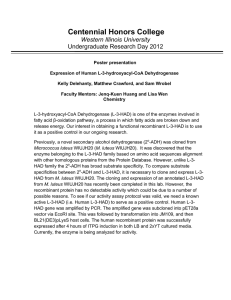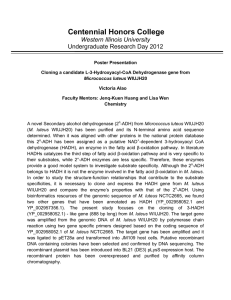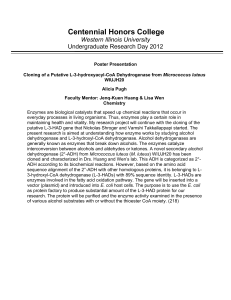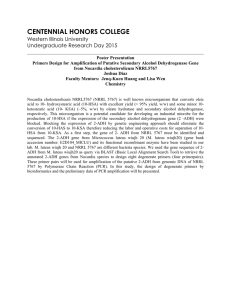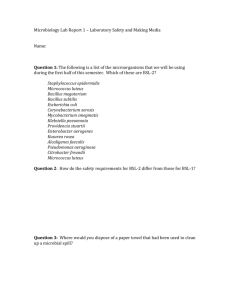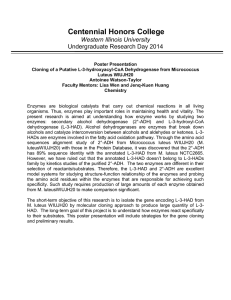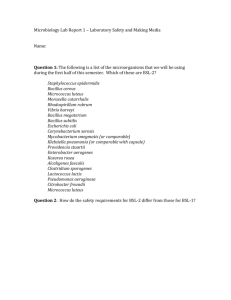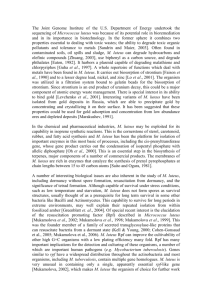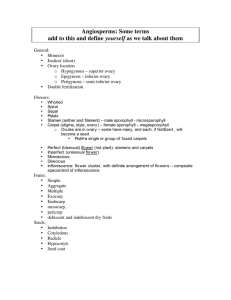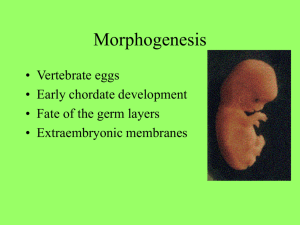Document 14240177
advertisement
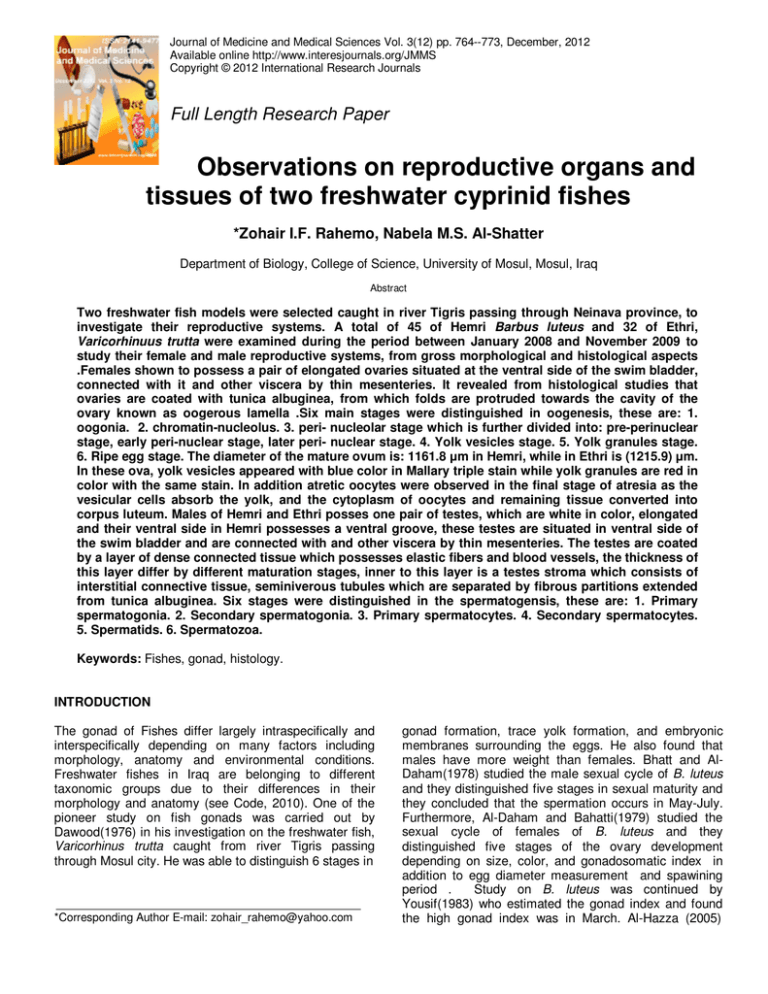
Journal of Medicine and Medical Sciences Vol. 3(12) pp. 764--773, December, 2012 Available online http://www.interesjournals.org/JMMS Copyright © 2012 International Research Journals Full Length Research Paper Observations on reproductive organs and tissues of two freshwater cyprinid fishes *Zohair I.F. Rahemo, Nabela M.S. Al-Shatter Department of Biology, College of Science, University of Mosul, Mosul, Iraq Abstract Two freshwater fish models were selected caught in river Tigris passing through Neinava province, to investigate their reproductive systems. A total of 45 of Hemri Barbus luteus and 32 of Ethri, Varicorhinuus trutta were examined during the period between January 2008 and November 2009 to study their female and male reproductive systems, from gross morphological and histological aspects .Females shown to possess a pair of elongated ovaries situated at the ventral side of the swim bladder, connected with it and other viscera by thin mesenteries. It revealed from histological studies that ovaries are coated with tunica albuginea, from which folds are protruded towards the cavity of the ovary known as oogerous lamella .Six main stages were distinguished in oogenesis, these are: 1. oogonia. 2. chromatin-nucleolus. 3. peri- nucleolar stage which is further divided into: pre-perinuclear stage, early peri-nuclear stage, later peri- nuclear stage. 4. Yolk vesicles stage. 5. Yolk granules stage. 6. Ripe egg stage. The diameter of the mature ovum is: 1161.8 µm in Hemri, while in Ethri is (1215.9) µm. In these ova, yolk vesicles appeared with blue color in Mallary triple stain while yolk granules are red in color with the same stain. In addition atretic oocytes were observed in the final stage of atresia as the vesicular cells absorb the yolk, and the cytoplasm of oocytes and remaining tissue converted into corpus luteum. Males of Hemri and Ethri posses one pair of testes, which are white in color, elongated and their ventral side in Hemri possesses a ventral groove, these testes are situated in ventral side of the swim bladder and are connected with and other viscera by thin mesenteries. The testes are coated by a layer of dense connected tissue which possesses elastic fibers and blood vessels, the thickness of this layer differ by different maturation stages, inner to this layer is a testes stroma which consists of interstitial connective tissue, seminiverous tubules which are separated by fibrous partitions extended from tunica albuginea. Six stages were distinguished in the spermatogensis, these are: 1. Primary spermatogonia. 2. Secondary spermatogonia. 3. Primary spermatocytes. 4. Secondary spermatocytes. 5. Spermatids. 6. Spermatozoa. Keywords: Fishes, gonad, histology. INTRODUCTION The gonad of Fishes differ largely intraspecifically and interspecifically depending on many factors including morphology, anatomy and environmental conditions. Freshwater fishes in Iraq are belonging to different taxonomic groups due to their differences in their morphology and anatomy (see Code, 2010). One of the pioneer study on fish gonads was carried out by Dawood(1976) in his investigation on the freshwater fish, Varicorhinus trutta caught from river Tigris passing through Mosul city. He was able to distinguish 6 stages in *Corresponding Author E-mail: zohair_rahemo@yahoo.com gonad formation, trace yolk formation, and embryonic membranes surrounding the eggs. He also found that males have more weight than females. Bhatt and AlDaham(1978) studied the male sexual cycle of B. luteus and they distinguished five stages in sexual maturity and they concluded that the spermation occurs in May-July. Furthermore, Al-Daham and Bahatti(1979) studied the sexual cycle of females of B. luteus and they distinguished five stages of the ovary development depending on size, color, and gonadosomatic index in addition to egg diameter measurement and spawining period . Study on B. luteus was continued by Yousif(1983) who estimated the gonad index and found the high gonad index was in March. Al-Hazza (2005) Rahemo and Al-Shatter 765 Figure 1. Photomicrograph of a section in the ovary of Barbus luteus showing oogerous lamellae (OI) arises from Tunica albuginea. Heamatoxylin-eosin (H-E), X100 during his investigation on B. luteus in Euphrate river originated from Turkey found that 70% of males and 75 % of females reaches maturity in the 2nd year and all reaches maturity at the third year, and the sex ratio was (1: 1). In Turkey, an extensive investigation was carried out in Karakaya Dam lake by Kalkam(2008), he found that V. trutta is the most abundant fish among cyprinids and the maximum gonad index was in May depending on morphology, size, weight of fishes examined. Furthermore, sexual maturity occurs in 2 -3 years and the reproductive period between March-July and the highest weight of gonad was in May and the highest egg diameter reached 1.04 mm and the sex ratio (1: 0.98). As it appear from above that there is no extensive gross morphological and histological on the gonad study on two selected cyprinid fishes namely B. luteus and V. trutta caught from River Tigris passing through Mosul city as such investigation was designed. MATERIALS AND METHODS A total 0f 45 specimens of Barbus luteus and 32 of Varicorhinus trutta were brought to the laboratory after have been caught from River Tigris passing through Mosul city. Total weight, total length was measured in addition to the removal of scales for age determination. After dissection testes and ovary were removed, examined gross morphologically, thin films were prepared from gonad to determine maturity. Gonads were fixed in Duboscq-Brasil or alcoholic Bouin were (see Gurr, 1962). Specimens were dehydrated, cleared in xylene, embedded in paraffin wax , sectioned at 8 – 10 microns then stained in Harris-haematoxylineeosin( Luna, 1968), Aldehyde-fuchsin(Ewen. 1962), Mallory triple stain(Culling et al., 1985), ammonical silver nitrate (Culling et al., 1985). Stained sections were examined and photographed using Olympus Microscope. Measurements were done using ocular micrometer. RESULTS AND DISCUSSION Female Reproductive System In both B. luteus and V. trutta a pair of elongated ovaries was observed in the coelomic cavity, each ovary is connected by other viscera by a mesovarian.its length from 12 – 36.5 cm in B luteus and 16.5 – 34 cm in V trutta and the mean weight 43.17 – 704.16 g and 79.90 – 608.73 g respectively . From each ovary a short oviduct emerge, both oviducts united to open to the outside by urinogenital opening. Ovaries are yellow with a granular appearance; the ovaries occupy 2/3 of the body. The above observation is similar to the description given in the studies on cyprinid fishes (Al_Daham and Bahatti, 1979; Al-Nouri 1996; Bardakci et al., 2000). The ovary of B. luteus is surrounded by thick germinal cuboidal epithelium while that of V. trutta by a thin peritoneum. Underneath this epithelium there is a connective tissue called tunica albugina which in turn surrounded by ovarian stroma at which female sex cells are embedded (Figure 1).Similar observations were seen by Al-Daham and Bahatti (1979) and Dawood (1976). It is revealed from the sections that tunica has growth 766 J. Med. Med. Sci. Figure 2. Photomicrograph of a section in the ovary of B.luteus illustrating the oogonia (Og) as single or cluster. H-E, X100 Figure 3. Photomicrograph of a section in the ovary of B. luteus showing oocyte in the chromatin-nucleolus stage (Cno) and the pre-perinucleolar oocyte(Ppn).H-E. X100 inside the ovary to form what is known as ovigerous lamellae which extend to the ovarian lumen (Figure 40), six stages of oogenesis can be distinguished, these are": 1-oogonia; 2-chromatin-nucleolus stage; 3-peri-nuclear stage;4-yolk vesicle stage; 5-yolk granules stage; 6-ripe egg stage Oogonia are arranged in a single or cluster stages (Figure 2), attended to ovigerous lamella, rounded nucleus or spherical occupy most of the cell space. Oogonia were easily distinguished from primary oocytes in their shape of nucleus as oogonia have oval nucleus, single nucleolus, chromophobic cells (Figures 35). These observations coincide with those of Figueiredo et al., 2008. In these fishes the maturing peri-nuclear oocytes contains numerous nucleoli scattered irregularly in the nucleoplasm as growth continue and increasing of the cells gradually and after that starting the migration of the peripheral nucleoli, fusion may happen between nucleoli before formation of yolk (Figures 6,7,8). Such migration and formation of yolk is similar to the conclusion of AlHamdani(1999) for the ovary of mosquito fish and those of Cakici and Uncuncu (2007) for the zebra fish, Danio s rerio. Furthermore, number of nucleoli in both fishes studied differ, similar differences were observed by the study of Fishelson et al., 2003(see Koc et al., 2008) who concluded that increasing of peripheral nucleoli is indication of starting of yolk formation, this means nucleoli have special role in the formation of rRNA (Al- Rahemo and Al-Shatter 767 Figure 4. Photomicrograph of enlarged oocyte of B. luteus in the peri-nuclear stage (Cno). H-E. X 400 Figure 5. Photomicrograph of a section on the ovary of Varicorhinus trutta showing oocyte in early peri-nucleolar stage (Epn), nucleus (N), nucleoli(NI). H-E X400 Figure 6. Photomicrograph of a section in the ovary of B. luteus showing late peri-nucleolar stage (Lpn) and the yolk nucleus (Yn). H-E. X400 768 J. Med. Med. Sci. Figure 7. Photomicrograph of a section in the ovary of B. luteus illustrating the oocyte in pre-perinucleolar stage(Ppn) and early peri-nucleolar stage (Epn) and the late peri-nucleolar stage possessing the yolk vesicles(Yv), small cells are intensively stained while the large are faintly stained.H-E., X100 Figure 8. Photomicrograph of a section in the ovary of V. trutta showing the oocyte with yolk vesicles(Yv) which stained with blue color and zona radiate(Zr) with red color. Mallory triple stain X40 Mokhtar et al., 1981). Oocytes contains a peculiar structure known as yolk nucleus (Figure 6) in both B. luteus and V. trutta when the cell pass in the peri-nuclear stage. Some scientists believe it is from nuclear or cytoplasmic origin (see Malhorata et al., 1978). The peri-nuclear follicular cells increase in their thickness and differentiations to be arranged into two rows of follicular cells which were very close to each other forming an external layer, the theca and the inner granular layer, the granulose (Figure 9). These observations coincide with similar results obtained by AlHamddani(1999) in the ovary of mosquito fish. In some ovary sections in B. luteus and V. trutta a yolk deposition rings which indicates starting of vitellogenesis and storage of yolk in oviparous fish during oogenesis. Some authors called these as yolk vesicles or lipid droplets or cortical alveoli (see Ravaglia and Maggese, 2002). It is worthy to note that the yolk vesicles were observed for the first time in cytoplasm of oocytes as vacuoles and in small number, small size in the peripheral part of cell, while yolk droplets formed inside these vacuoles leading to the formation of yolk vesicles which appeared in two fishes in 2-year old fishes, or more. These yolk vesicles increased in number and volume running parallel to the increase of oocytes (270 microns) in diameter in B. luteus starting yolk formation to reach 540 microns, and from 243 microns to 675 microns in V. trutta, then a new zone was found which granular in nature which is known as Rahemo and Al-Shatter 769 Figure 9. Photomicrograph of a section in the ovary of mature oocyte of V.trutta after its expulsion showing the follicle cells (Fc) of granular layer.H-E.X100 Figure 10. Photomicrograph of a section in the ovary of B. luteus showing late stage of atresia containing a damage tissue possessing scattered cells which is corpus luteum(CI)H-E.X 40 zona radiata. The above results agree with those of Al-Daham and Bahatti(1979) in B. luteus and Al-Nouri(1996) in A. marmid and by Figueiredo et al.,(2008) in Thunnus obescus. Inner to the zona radiata the yolk spheres are present which appear as red corpuscles after staining with Mallory triple. These spheres duplicates and increase in size, appear in cytoplasm between yolk follicles which appeared blue in color with same stain which accumulate in the center of oocyte and occupy ¾ of the cell. Such arrangement is due to accumulation of yolk which masks the observation of the nucleus. Also inner to zona radiata a new layer is formed known as vitelline membrane such finding can be confirmed by the previous observation of some authors ( Koc et al., 2008). The formation of yolk sphere indicates the yolk formation is about to finish, along with disappearance of nuclear membrane and the nucleoli and primary oocytes converted to mature or ripe eggs with a diameter of 1611 microns in B. luteus and 1215 microns in V. trutta as such are ready to lay out their eggs starting from March to July. Similar finding was found by Dawood (1976) and Al-Daham and Bahatti(1979). Furthermore increase in thickness of zona radiata from 10.8 micron to 18.9 microns in both B. luteus and V. trutta respectively was observed. This is in agree with the description given by Al-Daham and Bahatti(1979)in B. luteus and Cakici and Ucuncu(2007) in zebra fish, and those of Kayaba et al., 2001(see Cakici and Ucuncu, 2007) in japanees eel. In some ovary sections atretic ovary were observed (Figure10) such phenomena was described by some scientist (Al_Daham and Bahatti, 1979; Ravaglia and Maggese(2002) in the eel, Synbranchus marmoratus and Koc et al.,(2008) in D. rerio.In these ova, yolk vesicles appeared with blue color in Mallary triple stain while yolk granules are red in color with the same stain. In addition atretic oocytes were observed in the final 770 J. Med. Med. Sci. Figure 11. Photomicrograph of a section in the testis of B. luteum showing Tunica albunogena(Ta), clear blood vessels with nucleated RBC and eosinic cytoplasm near the seminiferous tube.H-E.X400 stage of atresia as the vesicular cells absorb the yolk, and the cytoplasm of oocytes and remaining tissue converted into corpus luteum (Figure 10). Males of Hemri, B. luteus and Ethri , V. trutta posses one pair of testes, their lengths from 2 -8.5 and 3 -6 cm respectively , white in color, elongated and their ventral side in Hemri possesses a ventral groove, these testes are situated in ventral side of the swim bladder and are connected with and other viscera by thin mesenteries. From each testis a vas deferns emerge, both from each side unite to form sperm duct which open through urinogenital opening. The testes are slender during resting stage became flattened, occupy two third of the body cavity. The above observations are similar to those found by Bhatti and Al-Daham(1978) during their study on B. luteus collected from Shatt Al-Arab, Dawood (1976) when investigated the gonad of Varicorhinus trutta, and Suwanjarat et al.,(2005) when studied the fish sand goby Oxyeleotris marmoratus, Dadzie and Abou-Seed(2004) when studied the fish, silvery croaker Otolithes ruber. The testis of B. luteus are tubular glands surrounded by testicular wall, consists of two layers outside is a peritoneum consist of cuboidal epithelium and the inner by tunica albugenia (Figure 11) which consist of connective tissue containing elastic fibers, some smooth muscles, fibroblasts and blood vessels. This layer is thick in the beginning of maturation becoming thin as maturation proceeded. The wall of the testis is known as testis stroma which consist of interstitial connective tissue and semineferous tubules which are rounded in shape . Similar results were obtained in Acanthobrama marmid by Al-Nouri(1996), and in Otolithes rubber by Dadzie and Abou-Seedo(2004) and in Oligasarcus hepseutus by Santos et al.,(2006).Each of the seminiferous tubule is surrounded by basal thin membrane, connective tissue, fibrocytes, smooth muscles and blood vessels, and inside each tubule nest of germinal epithelium connected to the basal membrane of the tubule long cells are supporting cells and Sertoli cells and the central cavity in each tube for sperm passing (Figures 12, 13, 14). Six stages of spermatogenesis were distinguished in both fishes , these are: 1-Primary spermatogonia; 2-Secondary spermatogonia;3Primary spermatocytes; 4-Secondary spermatocytes;5Spermatids;6-Spermatozoa The primary sperpatogonia in B. luteus are large in size lying in tubules they are arranged in single in B. luteus and as clusters in V. trutta, these nuclei are spherical in shape occupying most of the cell space and have basic staining ability, it has one or two nucleoli. Some differences are existing between the present fish in the primary spermatogonia and those described by Dadzie and Abou-Seedo 2004, Bhatti and AlDaham(1978) and Al-Nouri(1996). These differences may run with morphological differences and in turn with taxonomic differences. The secondary spermatogonia are present in cluster in both B.luteus and V. trutta they are ovoid cells with clear cell membrane, nuclei stained intensely, with single nucleolus. These results are in Rahemo and Al-Shatter 771 Figure 12. Photomicrograph of a section in the testis of V. trutta showing the lumen(arrow) of seminiferous tubule, primary spermatogonias as cluster(Sg) and primary spermatocyte(Pc) and secondary spermatocyte(Sc) close to the lumen.H-E X 400 Figure 13. Photomicrograph of a section in the testis of B. luteus showing primary spermatogonia(Pg) and secondary spermatogonia (Sg) primary spermatocytes(PC) and secondary spermatocytes(Sc), spermatids(St) and the short tails(arrows) of spermatozoa, blood vessels(Bv) between seminiferous tubules. H-E. X400 Figure 14. Photomicrograph of a section in a testis of B. luteus showing elongated seminiferous tubules, spermatids(St) as clusters, and the lumen inside the seminiferous tubules full of spermatozoa(Sz)/ H-E. X 100 772 J. Med. Med. Sci. Figure 15. Photomicrograph of a section in the testis of V. trutta showing spermetazoan and and some of the short tails(arrow). HE.X1000 agree with those found by Bahatti and Al-Daham (1978) for B. luteus and with Dawood (1976) for V. trutta and AlNouri (1996) in A. marmid. Primary spermatocytes are oval in shape, small 3.7 5.4 microns with spherical nucleus, nucleoli which are stained intensively with haematoxylin. These primary spermatocytes transfer into secondary spermatocytes, each with oval irregular nucleus. These observations similar to those of Dadzie and Abou-seed (2004). Spermatids are smaller than secondary spermatocytes present as clusters near the center of tubule, they are spherical in shape and their average diameter 2.7 microns. Spermatozoa are smallest cells, occupy the lumen of seminiferous tubules, about 1.5 microns in diameter, ovoid , nucleus appear to occupy most of the cell. In some sections spermatozoa were with tails. Sertoli cells are pyramid in shape, irregular, branched inside the tubules, large in size, always lie near primary spermatogonia and contain central nuclei, irregular in shape , their diameter is about 13.51 microns with large nucleolus with intense haematoxyline stain (Figure 15). As concern interstitial cells or Leydig cells present usually in interstitial tissue between the tubules sometime in single, 13.5 – 18.9 microns in length. These cells contain large nuclei with 8.1-10.8 micrometer in diameter, they are situated between seminiferous tubule with weakly stained acid cytoplasm , oval nucleus, clear nucleolus, single or cluster near blood vessels .Similar results were obtained by Al-Nouri (1996) in A. marmid , Rutaisire (2003) in ningu, Labeo victoninus while Dawood (1976) no such cells were observed. The nuclei of Sertoli cells which appear as ovoid or pyramid in shape and with eosinic cytoplasm which are frequently difficult to distinguish , these cells especially in the resting stage are similar to those observed in testes of the fish tambaqui, Colossoma macropomum described by Nakaghi et al.,( 2003). These cells were not recognized by Bahatti and Al-Daham(1978), Dawood(1976) possibly because they examined only mature fishes in which these cells atrophied or transformed into comma shape as concluded by Nakaghi et al., (2003). REFERENCES Al–Daham NK, Bhatti MN (1979). Annual changes in the ovarian activity of freshwater teleost, Barbus luteus (Heckel) from southern Iraq. J. fish Biol., 14:381–387. Al-Hamdani HM (1999). A study on embryonic development of Gambusia affinis (Baird and Girard). PhD thesis,University of Mosul. Al-Hazzaa RAL (2005). Some biological aspects of the Himri Barbus luteus, in the intermediate reaches of the Euphrates River. Turk. J. Zool. 29:311-315. Al-Mokhtar K, Al-Khateeb A, Abdul-Kareem M.A (1981). Embryology, Dar Al-Koteb, Baghdad, (in arabica) 41-43.s Al-Nouri A (1996). Study on the histological changes in the gonads of Acanthobrama marmid infected with Plerocercoid of Ligula intestinalis. M.Sc. thesis, University of Mosul, 59 p.s Bardakci I, Ozansoy U, Koptage E (2000). Acomparison of oogenesis under constant and fluctuating temperature in Doctor Fish, Garra rufa Heckel, 1843 (Teleostie: Cyprinidae). The World Wide Web J. Biol. (5):1-7. Bhatti MN, Al-Daham NK (1978). Annual cyclical changes in the testicular activity of a freshwater teleost, Barbus luteus (Heckel) from Shatt – Al – Arab, Iraq. J. fish Biol., 13: 321–326. Cakici O, Ucuncu SI (2007). Oocyte development in zebrafish, Danio rerio (Teleostei : cyprinidae). J. Fish. Aqat. Sci. 24: 137-141. Coad, B(2010). Freshwater fishes in Iraq. Pentsoft Sofia-Moscow Culling CFA, Allison RT, Barr WT (1985). Cellular pathology technique. Butterworth and Co. (Publishers) Ltd. London. Dadzie S, Abou-Seedo F (2004). Testicular structure and spawning cycle in the silvery croaker, Otolithes ruber (Perciformes: Sciaenidae) in the Kuwaiti waters of the Arabian Gulf. Ichthyol. Res. 51:263-268. Dawood HAN (1976). Studies on some aspects of the biology of Varicorhinus trutta (Heckel). M. Sc. Thesis, University of Mosul. Ewen AB (1962). An improved aldehyde-fuchsin staining technique for neurosecretory products in insects. Trans. Amer. Micros. Soc., 18:4496. Rahemo and Al-Shatter 773 Figueiredo MB, Santos AG, Travassos CM, Magalhaes BR (2008). Oocyte organization and ovary maturation of the big eye tuna (Thunnus obesus) in the west tropical Atlantic Ocean. Collect. 62(2):579-585. Gurr E (1962). Staining Animal Tissues. Practical and Theorotical.Leonard Hill, London. Kalkan, E. (2008). Growth and reproduction properties of Capoeta trutta (Heckel, 1843) in Karakaya Dam Lake. Turk. J. Zool. 32:1-10. Koc ND, Aytekin Y, Yuce R (2008). Ovary maturation stages and histological investigation of ovary of Zebrafish (Danio rerio). Braz. Arch. Biol. Technol. 51(3):513-522. Luna LG (1968). Manual of Histological staining Methods of the armed forces institute of pathology, 3rd ed., McGraw – Hill Book Company, New York. Malhotra XR, Jyoti MK, Cupta K (1978). Ovarian cycle and spawing season of of Ophicephalus punctatus, inhabiting Jammu waters, India. Jp. J. Ichthol. 25:190-195. Nakaghi LSO, Mitsuiki D, Santos HSL, Pacheco MR (2003). Morphometry and morphology of nucleus of Sertoli and interstitial cells of the tambaqui Colossoma macropomum (Cuvier; 1881) (Pisces: characidae) during the reproductive cycle. Braz. J. Biol. 63 (1):1-4. Ravaglia MA, Maggese MC (2002). Oogenesis in the swamp eel Synbranchus marmoratus (Bloch, 1795) (Teleostei ; synbranchidae). Ovarian anatomy, stages of oocyte development and micropyle structure. Biocell (Mendoza), 26(3):1-10. Rutaisire J (2003). The reproductive biology and artificial breeding of ningu Labeo victorianus (Pisces: cyprinidea). Ph. Dissertation. Rhodes University. Santos RN, Andrade CC, Santos LN, Santos AF (2006). Testicular maturation of Oligosarcus hepsetus (Cuvier) (Actinopterygii : Characidae) in a Brazilian tropical reservoir. Braz. J. Biol. 66 (1a São Carlos: 1-10. Suwanjarat J, Amornsakun T Thongboon L, Boonyoung P (2005). Seasonal changes of spermatogenesis in male sand goby Oxyeleotris marmoratus Bleeker, 1852 (Teleostei, Gobiidae) Songklanakarin J. Sci. Technol. 27:425-436. Yousif IH (1983). Ecological and Biological studies on Carasobarbus luteus Heckel and Liza abue Heckel in Mehajreen River, south of Basrah. M. sc. Thesis, College of Agriculture, University of Basrah.
